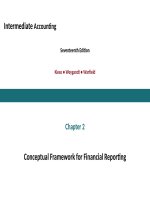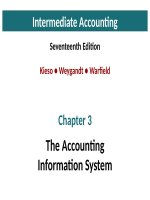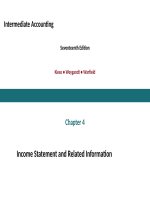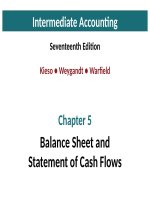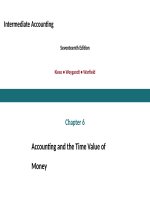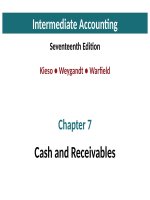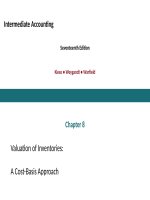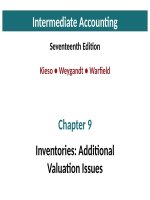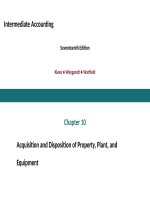Intermediate accounting 17e by kieso ch11
Bạn đang xem bản rút gọn của tài liệu. Xem và tải ngay bản đầy đủ của tài liệu tại đây (908.92 KB, 75 trang )
Intermediate Accounting
Seventeenth Edition
Kieso ● Weygandt ● Warfield
Chapter 11
Depreciation, Impairments, and Depletion
This slide deck contains animations. Please disable animations if they cause issues with your device.
Learning Objectives
After studying this chapter, you should be able to:
1.
Understand depreciation concepts and methods of depreciation.
2.
Discuss special depreciation methods and other depreciation issues.
3.
Identify the accounting issues related to asset impairment.
4.
Explain the accounting procedures for depletion of natural resources.
5.
Demonstrate how to report and analyze property, plant, equipment, and natural resources.
Copyright ©2019 John Wiley & Sons, Inc.
2
Preview of Chapter 11
Depreciation, Impairments, and Depletion
Depreciation
•
Factors involved
•
Methods of depreciation
Special Methods and Other Issues
•
Special depreciation methods
•
Other depreciation issues
Copyright ©2019 John Wiley & Sons, Inc.
3
Preview of Chapter 11
Impairments
•
Recognizing impairments
•
Measuring impairments
•
Restoration of loss
•
Assets to be disposed of
Copyright ©2019 John Wiley & Sons, Inc.
4
Preview of Chapter 11
Depletion
•
Establishing a base
•
Write-off of resource cost
•
Estimating reserves
•
Liquidating dividends
•
Continuing controversy
Copyright ©2019 John Wiley & Sons, Inc.
5
Preview of Chapter 11
Presentation and Analysis
•
Presentation
•
Analysis
Copyright ©2019 John Wiley & Sons, Inc.
6
Learning Objective 1
Describe Depreciation Concepts and Methods of Depreciation
LO 1
Copyright ©2019 John Wiley & Sons, Inc.
7
Depreciation—A Method of Cost Allocation
Depreciation is the accounting process of allocating the cost of tangible assets to expense in a
systematic and rational manner to those periods expected to benefit from the use of the asset.
Allocating costs of long-lived assets:
LO 1
•
Fixed assets = Depreciation expense
•
Intangibles = Amortization expense
•
Natural resources = Depletion expense
Copyright ©2019 John Wiley & Sons, Inc.
8
Factors Involved in the Depreciation Process
Three basic questions:
LO 1
1)
What depreciable base is to be used?
2)
What is the asset’s useful life?
3)
What method of cost apportionment is best for this asset?
Copyright ©2019 John Wiley & Sons, Inc.
9
Factors Involved in Depreciation
Depreciable Base for the Asset
Original cost
LO 1
$10,000
Less: Salvage value
1,000
Depreciation base
$ 9,000
Copyright ©2019 John Wiley & Sons, Inc.
10
Factors Involved in Depreciation
Estimation of Service Lives
LO 1
•
Service life often differs from physical life
•
Companies retire assets for two reasons:
1.
Physical factors (casualty or expiration of physical life).
2.
Economic factors (inadequacy, supersession, and obsolescence).
Copyright ©2019 John Wiley & Sons, Inc.
11
Methods of Depreciation
The profession requires the method employed be “systematic and rational.” Methods used include:
1.
2.
3.
Activity method (units of use or production).
Straight-line method.
Decreasing-charge methods (accelerated)
a.
b.
4.
Declining-balance method.
Special depreciation methods:
a.
b.
LO 1
Sum-of-the-years’-digits.
Group and composite methods.
Hybrid or combination methods.
Copyright ©2019 John Wiley & Sons, Inc.
12
Activity Method
Cost of crane
Stanley Coal Mines Facts
Estimated useful life
Estimated salvage value
Productive life in hours
$500,000
5 years
$ 50,000
30,000 hours
Illustration: If Stanley uses the crane for 4,000 hours the first year, the depreciation charge is:
LO 1
Copyright ©2019 John Wiley & Sons, Inc.
13
Straight-Line Method
Cost of crane
Stanley Coal Mines Facts
Estimated useful life
Estimated salvage value
Productive life in hours
$500,000
5 years
$ 50,000
30,000 hours
Illustration: Stanley computes depreciation as follows:
LO 1
Copyright ©2019 John Wiley & Sons, Inc.
14
Decreasing-Charge Methods
Cost of crane
Stanley Coal Mines Facts
Estimated useful life
Estimated salvage value
Productive life in hours
$500,000
5 years
$ 50,000
30,000 hours
Sum-of-the-Years’-Digits. Each fraction uses the sum of the years as a denominator (5 + 4 + 3 + 2 + 1 = 15). The
numerator is the number of years of estimated life remaining as of the beginning of the year.
Alternate sum-of-the-years’ calculation
LO 1
Copyright ©2019 John Wiley & Sons, Inc.
15
Sum-of-the-Years’-Digits
Depreciation Schedule
Year
a
LO 1
Depreciation
Remaining Life in
Base
Years
Depreciation Fraction
Depreciation
Book Value,
Expense
End of Year
1
$450,000
5
5/15
$150,000
$350,000
2
450,000
4
4/15
120,000
230,000
3
450,000
3
3/15
90,000
140,000
4
450,000
2
2/15
60,000
80,000
5
450,000
1
1/15
30,000
50,000
15
15/15
$450,000
Salvage value.
Copyright ©2019 John Wiley & Sons, Inc.
16
a
Decreasing-Charge Methods
Declining-Balance Method
Cost of crane
Stanley Coal Mines Facts
Estimated useful life
Estimated salvage value
Productive life in hours
•
Utilizes a depreciation rate (percentage) that is some multiple of the straight-line method.
•
Does not deduct the salvage value in computing the depreciation base.
LO 1
Copyright ©2019 John Wiley & Sons, Inc.
$500,000
5 years
$ 50,000
30,000 hours
17
Declining-Balance Method
Depreciation Schedule
Book Value
of Asset
Year
a
b
LO 1
First of Year
Balance
Rate on Declining
a
Balance
Depreciation
Accumulated
Book Value, End of
Expense
Depreciation
Year
1
$500,000
40%
$200,000
$200,000
$300,000
2
300,000
40%
120,000
320,000
180,000
3
180,000
40%
72,000
392,000
108,000
4
108,000
40%
43,000
435,200
64,800
5
64,800
40%
14,800
450,000
50,000
b
Based on twice the straight-line rate of 20% ($90,000/$450,000 = 20%; 20% × 2 = 40%).
Limited to $14,800 because book value should not be less than salvage value.
Copyright ©2019 John Wiley & Sons, Inc.
18
Methods of Depreciation
Illustration—(Four Methods): Maserati Corporation purchased a new machine for its assembly process on August 1,
2017. The cost of this machine was $150,000. The company estimated that the machine would have a salvage value of
$24,000 at the end of its service life. Its life is estimated at 5 years and its working hours are estimated at 21,000 hours.
Year-end is December 31.
Instructions: Compute the depreciation expense under the following methods.
(a)
Straight-line depreciation.
(b)
Activity method
(c)
Sum-of-the-years’-digits.
(d)
Double-declining balance.
LO 1
Copyright ©2019 John Wiley & Sons, Inc.
19
Straight-Line Method
Depreciation Schedule
Current
Depreciable
Annual
Years
Expense
Partial
Year
Accum.
Year
Expense
Deprec.
Year
Base
2017
$126,000
/
5
=
$25,200 ×
5/12
=
$ 10,500
$ 10,500
2018
126,000
/
5
=
25,200 ×
=
25,200
35,700
2019
126,000
/
5
=
25,200 ×
=
25,200
60,900
2020
126,000
/
5
=
25,200 ×
=
25,200
86,100
2021
126,000
/
5
=
25,200 ×
=
25,200
111,300
2022
126,000
/
5
=
25,200 ×
7/12
=
14,700
126,000
$126,000
Journal entry:
2017
Depreciation Expense
10,500
Accumultated Depreciation
LO 1
Copyright ©2019 John Wiley & Sons, Inc.
10,500
20
(Assume 800 hours used in 2017)
Activity Method
($126,000/21,000 hours = $6 per hour)
Depreciation Schedule
Current
(Given)
Rate per
Annual
Partial
Year
Accum.
Year
Hours
Hours
Expense
Year
Expense
Deprec.
2017
800
$4,800
$4,800
×
$6
=
2018
×
=
2019
×
=
$4,800
2020
×
=
2021
×
=
800
$4,800
Journal entry:
2017
Depreciation Expense
4,800
Accumultated Depreciation
LO 1
Copyright ©2019 John Wiley & Sons, Inc.
4,800
21
Sum-of-the-Years’-Digits Method
Depreciation Schedule (7/12 = .58333)
Current
Depreciable
Annual
Years
Expense
Partial
Year
Accum.
Year
Expense
Deprec.
Year
Base
2017
$126,000
×
5/15
=
$42,000
×
5/12
=
$ 17,500
$ 17,500
2018
126,000
×
4.583/15
=
38,500
×
=
38,500
56,000
2019
126,000
×
3.583/15
=
30,100
×
=
30,100
86,100
2020
126,000
×
2.583/15
=
21,700
×
=
21,700
107,800
2021
126,000
×
1.583/15
=
13,300
×
=
13,300
121,100
2022
126,000
×
.583/15
=
4,900
×
=
4,900
126,000
$126,000
Journal entry:
2017
Depreciation Expense
17,500
Accumultated Depreciation
LO 1
Copyright ©2019 John Wiley & Sons, Inc.
17,500
22
Double-Declining Balance Method
Depreciation Schedule
Depreciable
Rate Per
Annual
Year
Base
Year
2017
$150,000
×
40%
=
$60,000
×
5/15
=
$ 25,000
$ 17,500
2018
125,000
×
40%
=
50,000
×
=
50,000
56,000
2019
75,000
×
40%
=
30,000
×
=
30,000
86,100
2020
45,000
×
40%
=
18,000
×
=
18,000
107,800
2021
27,000
×
40%
=
10,800
×
Plug
=
3,000
121,100
$126,000
$126,000
Expense
Partial
Current Year
Accum.
Year
Expense
Deprec.
Journal entry:
2017
Depreciation Expense
25,000
Accumultated Depreciation
LO 1
Copyright ©2019 John Wiley & Sons, Inc.
25,000
23
Learning Objective 2
Discuss Special Depreciation Methods and Other Depreciation Issues
LO 2
Copyright ©2019 John Wiley & Sons, Inc.
24
Special Depreciation Methods and Other Issues
Special Depreciation Methods
Two methods of depreciating multiple-asset accounts exist:
•
Group method used when the assets are similar in nature and have approximately the same useful lives.
•
Composite method used when the assets are dissimilar and have different lives.
Choice of method depends on the nature of the assets involved.
The computation for group or composite methods is essentially the same: find an average and depreciate on that
basis.
LO 2
Copyright ©2019 John Wiley & Sons, Inc.
25
